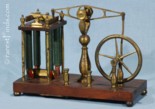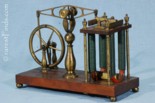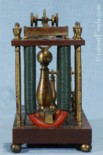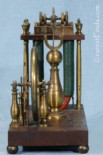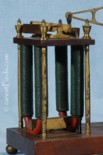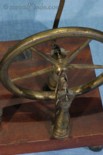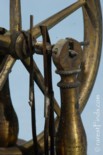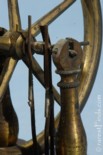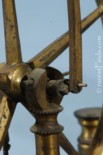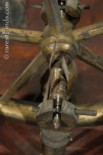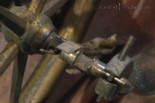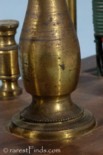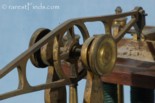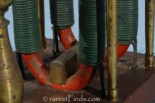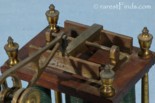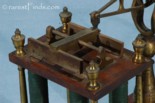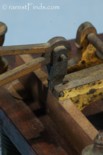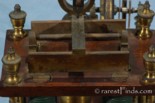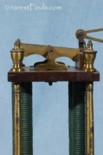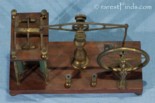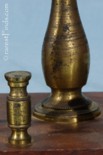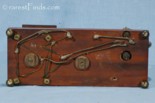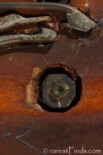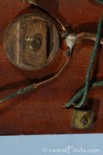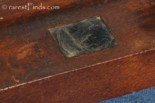Exceedingly rare demonstration model of the Reciprocating Electro-Magnetic Engine invented by Charles Page in 1839
Today, we hear very little, if anything, about Thomas F. Davenport, the
blacksmith who invented the electric motor; or about De Jacobi, who propelled
the first boat by means of an electric motor; or of Charles Page who successfully carried
passengers on the first practical electric railway.
With the invention of the battery (Allessandro Volta, 1800), the generation of a
magnetic field from electric current (Hans Christian Oersted, 1820) and the
electromagnet
(William Sturgeon, 1825) the foundation for building electric motors was laid
and it was just a matter of time till some scientist would invent the
Electromagnetic motor.
Davenport applied for a patent on January 24, 1837, and his application was
granted the patent with the number 132 just 30 days later, on February 25, 1837.
Thomas F. Davenport therefore rightfully deserves the title of inventor of the
Electromagnetic motor. Like so many great inventors, Davenport was ahead of his
time, his patent not used, and he died penniless in 1851. Had it not been for
the efforts of Davenport, Jacobi, and Page, somebody else would have made the
invention soon thereafter; the time was ripe.
At the time (1830's and 1840's) it was still open whether electromagnetic
motors should be rotating or reciprocating machines, i.e. simulate a plunger rod
of a steam engine. While Davenport's motor was resembling a rotating design,
Page's motor was based on the plunger type, resembling a steam engine.
Page replaced the piston generating the force transmitted to the flywheel by a
beam with four electromagnets.
Examples of these early motors and
demonstration models are practically none existent and only to be found in major
collections and museums of antique electric motors.
To read about the invention of the electric motor with a time-line,
click here!
The antique Electro-Magnetic Motor offered here was named, "The Reciprocating
Electro-Magnetic Engine", was invented by Charles Grafton Page, and was first
described in Benjamin Silliman's American Journal of Science, vol XXXV, Art. V.
Magneto-Electric and Electro-Magnetic Apparatus and Experiments; by CHARLES G.
PAGE, M.D., page 252-268, November 13th, 1838. Benjamin Silliman American
Journal of Science is the oldest Scientific Journal published in the United
States, and was founded in 1818.
In his article, Page describes the effects of Faraday's Law of Induction and,
Lenz's Law of Electromagnetic Induction based on experiments he conducted. and their effects in the construction of efficient electro-magnetic coils and
motors. Page then describes a circular Galvanometer, a Revolving Armature, and finally his Reciprocating Armature Engine of which a demonstration model is offered her for sale. To read the entire article,
click here!
The following description is part of the article above and printed on page 263, with the title, "Reciprocating Armature Engine":
Figure 6, [click on image to enlarge!] represents an electro-magnetic engine with vibrating or reciprocating armatures. a, a, are the electro-magnets, firmly secured to the base board and the wooden table t.The following description is published in, "DAVIS'S MANUAL OF MAGNETISM, by DANIAL DAVIS JR., MAGNETICAL INSTRUMENT MAKER, 1842, BOSTON," page 112:b, b, are the armatures of soft iron connected with the shaft (d) by stout brass arms. The balance beam, connecting rods, and balance wheel, represented in the figure, require no particular description. The cut-off by which the magnets are alternately charged, is on the shaft of the balance wheel at m. It is simple in construction, made of silver, and similar to the one described for the revolving armature. There are three conducting springs tipped with silver, one playing upon the whole portion, and two upon the dissected portion of the cut-off. The connexions of the magnet wires with the springs and cups p, n, for battery connexion, are made under the base boards, and are marked by dotted lines.
Several of these engines have been made by Mr. Daniel Davis, Jr., philosophical instrument maker, of Boston; and are beautiful working models. As a proof that electro-magnetism is susceptible of useful application where only a small power is wanted a small engine was made by Mr. Davis in the month of July last, by the aid of which, an individual gains fifteen dollars per day by simple operation of drilling the steel plates for gas burners. I think this may be considered the first instance in which the mechanical application of electro-magnetism has been turned to profitable account. This engine is to undergo considerable alteration and improvement, when a description and drawing of it will be published.
Reciprocating Armature Engine - In this instrument, contrived by Dr. Page, two electro-magnets of the U form, represented at M M (fig 140), are firmly secured in a vertical position, the four poles appearing just above a small wooden table. The two armatures, A A, connected by a brass bar, move upon a horizontal axis in such a manner that while one is approaching the poles of the magnet over which it is placed, the other is receding from those of the magnet. The brass bar is connected with one extremity of a horizontal beam, the other end of which communicates motion by means of a crank to a flywheel. On the axis of the flywheel at B is the break-piece. Each magnet being charged in succession, the armatures are attracted alternately, communicating a rapid reciprocating motion to the beam, and consequently a rotary one to the flywheel.To read Davis's manual, click here!
Condition:
This exceedingly rare demonstration model of Charles Pages Reciprocating
Electro-Magnetic Engine is in original condition retaining its original clear
lacquer on all the brass pieces, original paint on the magnets, and original wiring. The
steel parts are free of corrosion besides some patina. The model is all
complete and free of defects, breaks, or repairs. As far as the writer is concerned, this rare early demonstration model of an early electric motor is all original and untouched!
The heavy 5 spoke flywheel measures 3 3/4" inches in diameter. The horizontal brass beam is 6 inches
long. All of the still functioning wiring is concealed under the wooden base.
The "break-piece" consists simply of two strips of sheet brass soldered to the
appropriate wire and positioned so that they will rub against the flywheel
shaft, which is cut away on one side not unlike
a camshaft of an internal combustion engine to cause the strips to alternately
come in contact with the shaft to connected the two coils alternately. These strips are still in perfect shape. When
connected to a power supply, the motor runs continuously and quite rapidly.
History:
Charles Grafton Page (pictured to the right) was born January 25, 1812 in Salem, Massachusetts,
and died May 5, 1868 in Washington D.C.
Page graduated from Harvard College and later from the Harvard
Medical School, and was, at various times in his career a physician, a patent
examiner and a patent agent. He spent the years from 1836 to 1839 as an
electrical scientist and inventor, publishing about forty papers on his work.
Page was one of the inventors of the induction coil, and invented, patented, and developed early
versions of reciprocating and rotary electromagnetic motors.
Page is in the National Inventors Hall of Fame; his invention of the reciprocating electro-magnetic engine is mentioned in the listing on-line. To see the narrative,
click here!
Page invented the Circuit Breaker you find where ever electrical istallations are to be found,
click here; to read the patent of the Circuit Breaker,
click here!
A number of pieces of apparatus manufactured by famous scientific instrument maker Daniel
Davis Jr., were designed by Charles Grafton Page or developed from his
suggestions.
There is no doubt that this exceedingly rare demonstration model was crafted by
Daniel Davis Jr; please compare the finial on top of the Rotating Bell Engine described in Davis's Manual as his own on page 104 and
shown here, with the finials on the Charles Page engine offered here.
To see for yourself,
click here!
To read Page's obituary,
click here!
REFERENCE: . Robert C. Post, Physics, Patents and Politics (Science History
Publications, New York, 1976)
Inventory Number 09328;
Price: Sold!
